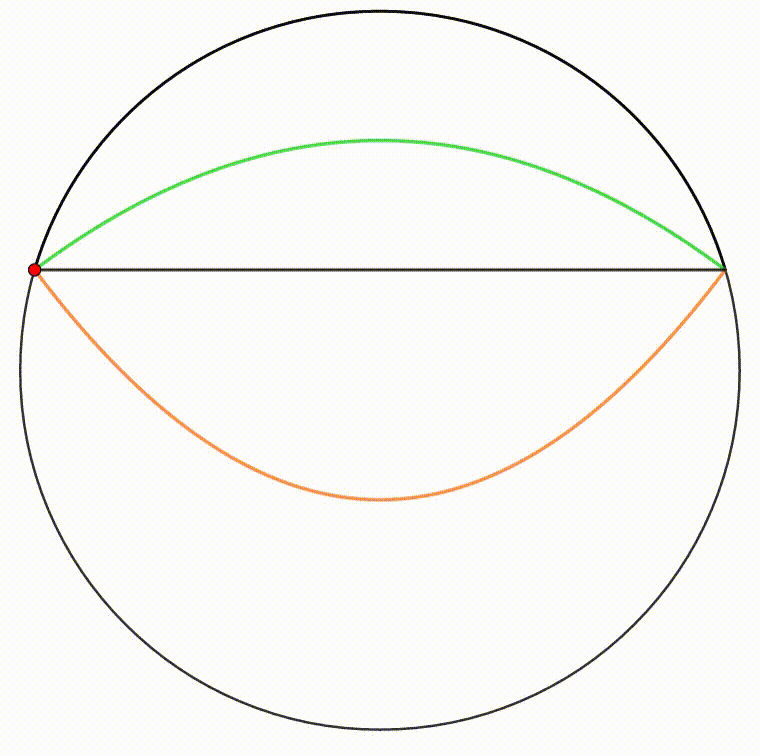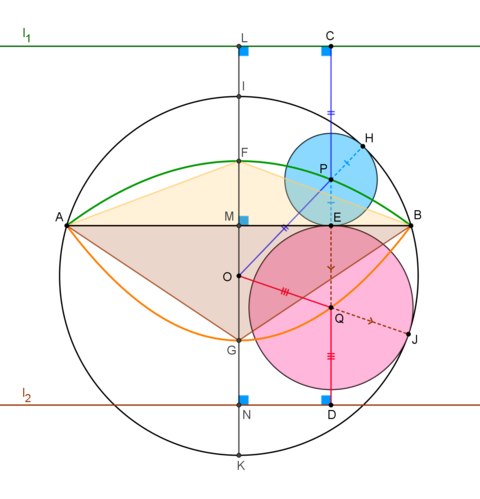Dynamic Geometry: P28

A circle with radius 2 5 is slip into two segments by a chord. The larger segment has a height of 3 2 . The green curve and the orange curve are loci of the centers of all circles tangent internally to the arc and the chord of the smaller segment and the larger segment respectively.
The area bounded by the green and orange curves is an integer. Find the sum of digits of the integer.
The answer is 8.
This section requires Javascript.
You are seeing this because something didn't load right. We suggest you, (a) try
refreshing the page, (b) enabling javascript if it is disabled on your browser and,
finally, (c)
loading the
non-javascript version of this page
. We're sorry about the hassle.
2 solutions
Thank you sir !
 Referring to the figure,
O
is the center of the big circle,
P
and
Q
are the centers of the two small circles.
H
,
J
and
E
are points of tangency of the circles. Line
L
K
is the perpendicular bisector of the cord
A
B
and both lines
l
1
,
l
2
are perpendicular to
L
K
, such that
M
L
=
M
N
=
R
.
C
D
is perpendicular to
A
B
through
P
,
E
and
Q
.
Referring to the figure,
O
is the center of the big circle,
P
and
Q
are the centers of the two small circles.
H
,
J
and
E
are points of tangency of the circles. Line
L
K
is the perpendicular bisector of the cord
A
B
and both lines
l
1
,
l
2
are perpendicular to
L
K
, such that
M
L
=
M
N
=
R
.
C
D
is perpendicular to
A
B
through
P
,
E
and
Q
.
First we calculate the length of cord A B .
By Intersecting cords theorem, A M ⋅ M B = I M ⋅ M K ⇔ A M 2 = ( 2 R − M K ) ⋅ M K ⇔ ( 2 A B ) 2 = ( 5 0 − 3 2 ) × 3 2 ⇔ A B = 4 8
Next, we prove that the green and orange curves are parts of two parabolas.
Indeed, O P = O H − P H = R − P E = C E − P E = C P Thus, the green curve is a parabola. O is its focus, the green line l 1 is its directrix and the midpoint of M I , F , is its vertex.
Similarly, O Q = O J − Q J = R − Q E = D E − Q E = D Q Thus, the orange curve is also a parabola, with O being its focus, line l 2 its directrix and the midpoint of M K , G its vertex.
The area in question is the sum of the areas of two parabolic segments bounded by the parabolas and their common cord A B .
Now, in his treatise The Quadrature of the Parabola , Archimedes proves that
the area of a parabolic segment is 3 4 that of the triangle whose base is the given chord of the parabola, and the third vertex is the point on the parabola such that the tangent to the parabola at that point is parallel to the chord.
In our case, this triangles are F A B and G A B , hence,
Area in question = 3 4 [ F A B ] + 3 4 [ G A B ] = 3 4 × 2 1 A B ⋅ F M + 3 4 × 2 1 A B ⋅ G M = 3 2 A B ( F M + G M ) = 3 2 A B ( 2 I M + 2 M K ) = 3 2 A B 2 I K = 3 2 A B ⋅ R = 3 2 × 4 8 × 2 5 = 8 0 0 For the answer, the sum of the digits of the area is 8 .
Well @Thanos Petropoulos I think this is the most impressive solution you offered me so far. I need to get into Archimede works anyway... There is a small Typo when you cite the proof
Log in to reply
Thanks. I guess you already know Archimedes' Book of Lemmas . If not, it's a good place to start.
Both the loci are parabolas (see proof below), therefore the area bounded by them is 3 2 the area of the blue rectangle. The height of the rectangle is 9 + 1 6 = 2 5 and its width w = 2 2 5 2 − 7 2 = 4 8 . Therefore the area enclosed by the two loci is 3 2 × 2 5 × 4 8 = 8 0 0 , whose sum of digits is 8 .
Proof:
Let the center of the large circle be the origin O ( 0 , 0 ) of the x y -plane, the dividing chord is parallel to the x -axis and is at a distance h from O . Let a point on the locus be P ( x , y ) when the radius of the inscribed circle is r . Then we note that y = r + h , ⟹ r = y − h , and:
x 2 ⟹ y = ( R − r ) 2 − y 2 = ( R − y + h ) 2 − y 2 = ( R + h ) 2 − 2 ( R + h ) y + y 2 − y 2 = 2 R + h − 2 ( R + h ) x 2
The equation is a parabola. Since the derivation is general, both the green and orange curves are parabolas.